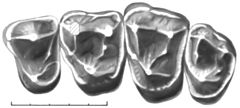Project 3328: M. A. O'Leary. 2021. A dense sample of fossil primates (Adapiformes, Notharctidae, Notharctinae) from the Early Eocene Willwood Formation, Wyoming: Documentation of gradual change in tooth area and shape through time. American Journal of Physical Anthropology. 174 (4):728-743.
Abstract
ObjectivesThe Willwood Formation of the southern Bighorn Basin, Wyoming is a fluvial rock sequence that spans approximately 3 million years of early Eocene time. It has yielded one the largest collections of fossil mammals in the world including thousands of dentitions of extinct lemur‐like primates known as notharctines. In the southern Bighorn Basin, specimens of these primates have been collected on numerous paleontological expeditions and the stratigraphic levels yielding the dentitions have been carefully recorded. Notharctine dentitions represent a rare opportunity to study morphological variation in a single anatomical system through time among closely related individuals.Materials and MethodsPrior studies of Bighorn Basin notharctines through time produced measurements of hundreds of specimens but I report here results from measurement and comparison of the dentitions and dentaries of more than 3,000 specimens, all stratigraphically mapped.ResultsVariation in premolar and molar area and variation in dentary depth are apparent throughout the section. Specimens with relatively small teeth and dentaries are known from the older part of the section. In younger rocks, variation in tooth area among specimens increases. Variation in tooth area is continuous and overlaps extensively both within and between stratigraphic levels. Other dental variables examined by inspection change in a mosaic and continuous fashion through the section. These features include variation in the presence and number of paraconids on the lower fourth premolar (p4), the size and shape of the entoconid notch on the lower first and second molars, and the relative development of the pseudohypocone, mesostyle, and cingula on the upper molars.DiscussionThese broad patterns can be identified despite notharctine alpha taxonomy being in need of extensive revision and, importantly, simplification. Such revision is beyond the scope of this article but is essential if we are to develop a taxonomy that is both free of stratigraphic influence and useful for rapid, repeatable species assignment. Boundaries among the patterns of tokogenesis, anagenesis, and cladogenesis are blurred in this dense sample of extinct primates. While pattern of evolution, a population‐level phenomenon, may be difficult to falsify in the fossil record, this notharctine sample suggests that in the rare instance such as this, when the fossil record is densely sampled, change through time is continuous and more consistent with gradual evolution.Read the article »
Article DOI: 10.1002/ajpa.24177
Project DOI: 10.7934/P3328, http://dx.doi.org/10.7934/P3328
| This project contains |
|---|
Download Project SDD File |
Currently Viewing:
MorphoBank Project 3328
MorphoBank Project 3328
- Creation Date:
02 November 2018 - Publication Date:
21 December 2020
This research
supported by
Authors' Institutions ![]()
- American Museum of Natural History (AMNH)
- Stony Brook University
Members
| member name | taxa |
specimens |
media |
| Maureen O'Leary Project Administrator | 2 | 12 | 17 |
Project has no matrices defined.
Project downloads 
| type | number of downloads | Individual items downloaded (where applicable) |
| Total downloads from project | 93 | |
| Project downloads | 81 | |
| Document downloads | 12 | Supplemental Table S1 (6 downloads); Appendix 1 (5 downloads); Supplemental Figure S1. Sample outlines for tooth area measurements (1 download); |

